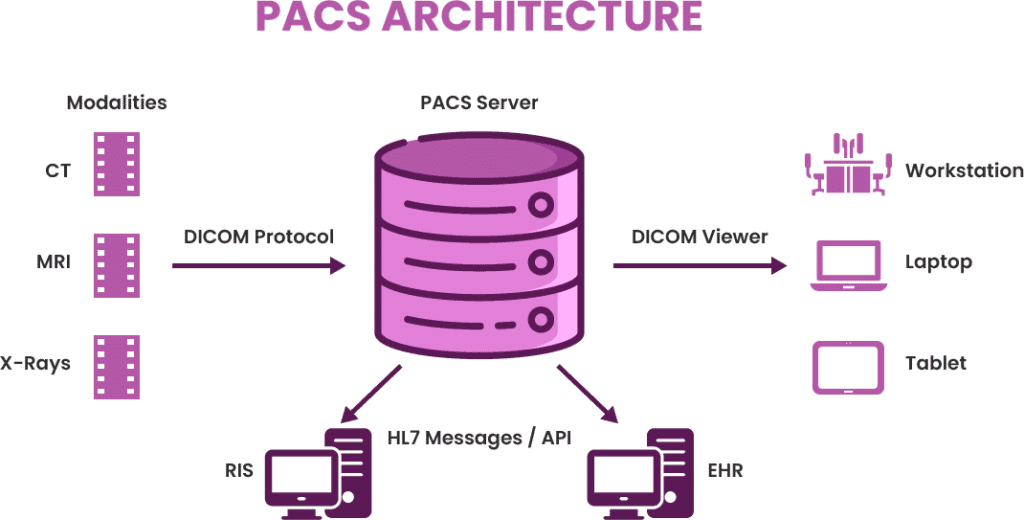
Imagine a world where radiologists can effortlessly access and interpret medical images from anywhere, at any time. This is the reality of PACS and RIS system. With the ever-increasing demand for healthcare services, fast and accurate processing of healthcare information is critical. Although both RIS and PACS are highly critical systems, they have long been pushed to the forefront of essential technology transforming how healthcare facilities store, manage and ultimately leverage medical imaging data.
The Power of PACS and RIS System
In today’s healthcare world, efficiency and accuracy are everything. Radiology Information Systems (RIS) and Picture Archiving and Communication Systems (PACS) are the dynamic duo transforming how healthcare facilities handle imaging data.
At the heart of RIS and PACS lies their ability to:
- Centralize image storage and retrieval: Say goodbye to the chaos of manual image storage and retrieval. PACS provides a centralized, secure repository for all your medical images.
- Managed workflows: RIS automates administrative tasks, freeing up radiologists to focus on what they do best: interpreting images.
- Improve image quality: PACS ensures that images are displayed and manipulated with precision, aiding in accurate diagnosis.
- Enable effective collaboration: Share images and reports effortlessly with colleagues, regardless of their location.
- Enhance patient care: By improving efficiency and accuracy, RIS and PACS contribute to better patient outcomes.

The Importance of RIS and PACS for Hospital Labs
RIS and PACS tools are the lifeblood of modern labs, ensuring efficient image management, seamless integration, remote access, and top-notch quality assurance.
Hospital laboratories rely heavily on PACS and RIS system for:
- Efficient image management: Store and retrieve vast amounts of medical images with ease.
- Effective integration: Integrate with laboratory information systems (LIS) for smooth data exchange.
- Remote access: Enable radiologists to work from anywhere without compromising image quality.
- Quality assurance: Ensure compliance with regulatory standards and maintain high image quality.
Essential Tools for Radiologists: Beyond PACS and RIS system
While RIS and PACS form the backbone of modern radiology departments, radiologists also rely on a variety of other software tools to enhance their workflow and improve patient care.
Key Software Tools for Radiologists
- DICOM Viewers: These specialized software applications allow radiologists to view, manipulate, and analyse medical images in DICOM format. Popular options include Horos, Osirix, and MicroDicom.
- Image Analysis Software: For advanced image analysis tasks, radiologists often turn to software like ImageJ, Analyze, and Osirix. These tools can help detect abnormalities and measure anatomical structures.
- Speech Recognition Software: Dictating radiology reports can be time-consuming. Speech recognition software like Dragon Medical and Fusion Narrate streamline this process, allowing radiologists to focus on interpreting images.
- 3D Reconstruction Software: Visualizing complex anatomy is easier with 3D reconstruction software. Tools like Mimics and Osirix can create detailed 3D models from medical images.
- Teleradiology Software: Remote image interpretation is made possible with teleradiology software. This is particularly useful for smaller hospitals or practices without in-house radiologists.
- EHR Integration: Seamless integration with electronic health record (EHR) systems ensures that radiology reports and images are readily accessible to other healthcare providers.
The Future of PACS and RIS system
As technology continues to advance, we can expect to see even more innovative applications of RIS and PACS. Some exciting developments include:
- AI-powered image analysis: Let artificial intelligence assist radiologists in interpreting images, improving accuracy and efficiency.
- Cloud-based solutions: Embrace the flexibility and scalability of cloud-based RIS and PACS.
- Enhanced integration: Seamlessly integrate RIS and PACS with other healthcare systems for a more connected workflow.
- Advanced cybersecurity: Protect sensitive patient data with cutting-edge security measures.
Conclusion
In conclusion, RIS and PACS are essential tools for modern healthcare facilities. By streamlining workflows, improving image quality, and facilitating collaboration, these systems contribute to better patient care and operational efficiency. As technology continues to evolve, we can expect to see even more innovative applications of RIS and PACS in the future.





